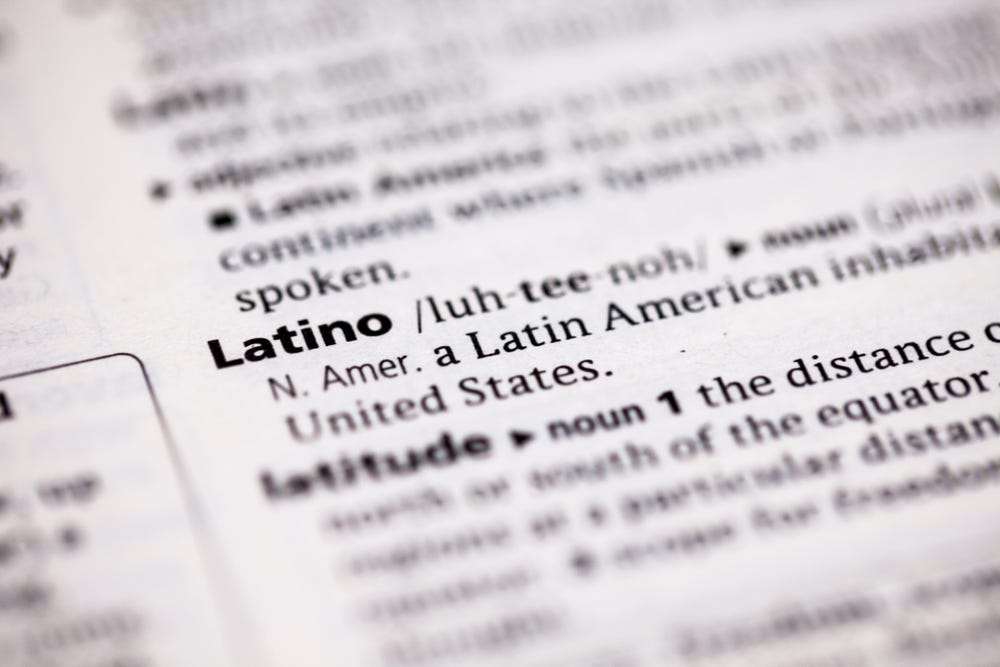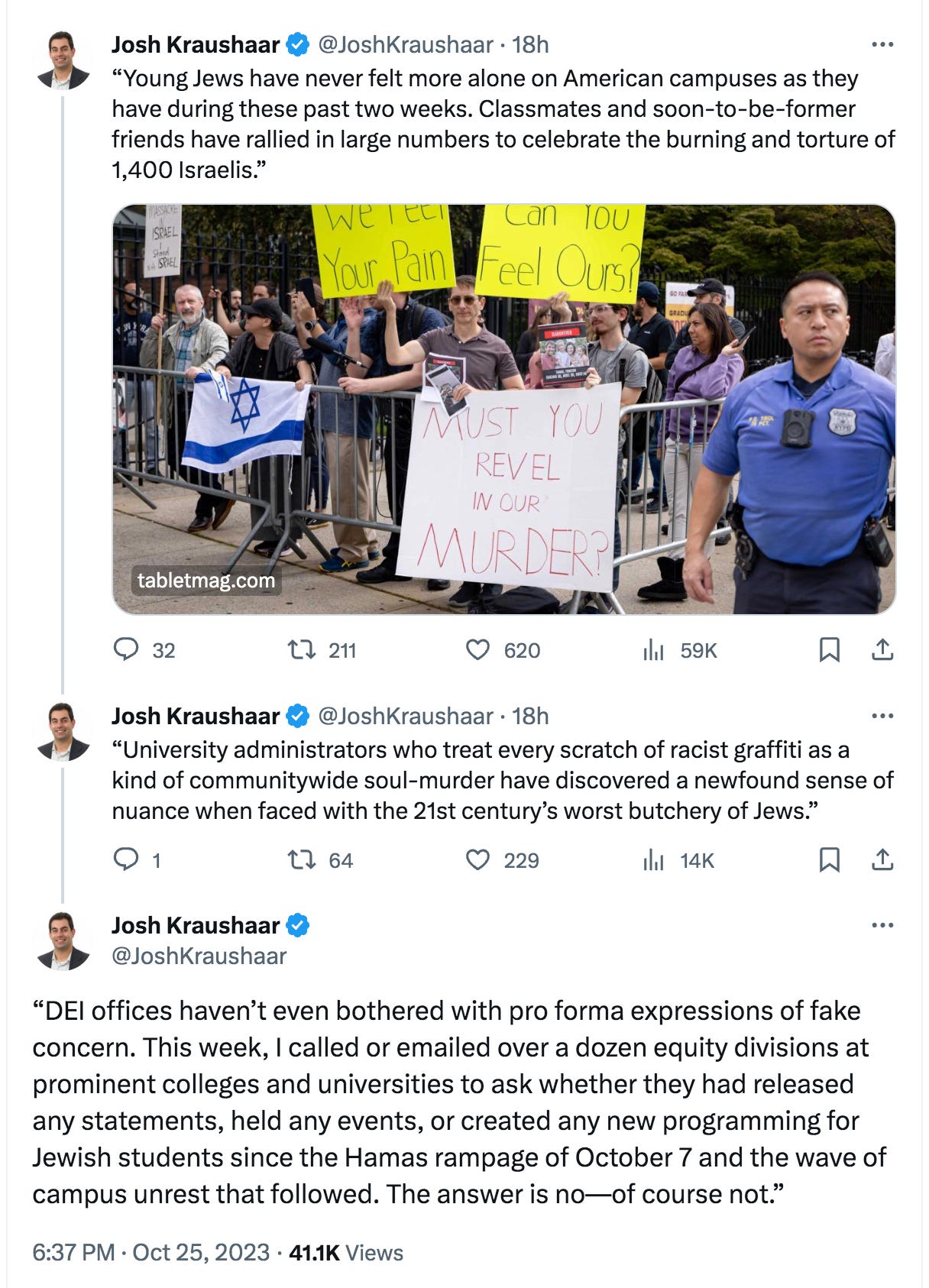E-Pluribus | October 26, 2023
Why liberals should leave the left; how reporting on Hamas exposes the state of war journalism; and ethnic identity should not trump individual identity.
A round-up of the latest and best musings on the rise of illiberalism in the public discourse:
Robert Tracinski: The Hamas Attack Shows Why Liberals Should Break With the Left
One of the more disturbing aspects of the response to the Hamas attacks on Israel has been the realization that no atrocity is too great to be excused in some quarters. Writing for Discourse Magazine, Robert Tracinski urges liberals appalled by the Hamas cheer-leading to distance themselves from the left and clarify their commitment to basic humanity and individual rights, which are fundamental to classical liberalism.
Many observers have been noticing the recent confluence of the pro-Hamas left and the white-nationalist right—killing Jews is a cause that joins antisemites of all persuasions—and citing this as proof of “horseshoe theory.” That’s the idea that the traditional right-versus-left political spectrum is not a straight line with opposing poles but rather a horseshoe in which the far ends bend toward one another and become nearly indistinguishable. As New York magazine’s Levitz notes, when American leftists endorse Hamas, they are backing “a far-right theocratic organization committing mass murder in the name of blood-and-soil nationalism.”
[. . .]
What unites the far left and the far right is not merely a philosophy that dehumanizes the enemy, but one that dehumanizes the individual. That’s the hallmark of the reaction to this new war in Israel. Civilians die in every war, and even a legitimate war of self-defense cannot be run so cleanly as to spare all innocents. But what distinguishes the barbarity of Hamas, and of its leftist defenders, is the act of prioritizing and celebrating civilian deaths.
[. . .]
Liberalism in the broad sense, as opposed to every kind of illiberalism, is the belief in a society defined by freedom. But beneath that there is a simpler and more elemental principle: the value of the individual human life. Levitz describes it as a “fundamental commitment to the inherent worth of every human life.” This is the bond that all the different strands of liberalism ought to be able to agree on.
[Ruy] Teixeira wants liberals to “throw the intersectional left under the bus” and embrace this kind of “universalistic principle.” It’s going to be a wrenching thing for them to do, to turn away from people they regard as indispensable political allies and even as friends. But many who thought of themselves as being on “the right” have already had to do this in recent years. When the Republican Party reaches the point where it is now a matter of debate whether it’s OK to pal around with white nationalists, you get some idea of what we have been through in the Trump years.
To be sure, many on the right failed this challenge. But that should, if anything, be an extra incentive for liberals to do better. The chaos and collapse of today’s conservative movement is a cautionary tale of what happens when you wait too long. As The Atlantic’s Beckerman notes, the “same ideological hardening I’d seen on the right in the past few years, the blind allegiances and contorted narratives even when reality was staring people in the face, has also happened, to a greater degree than I’d imagined, on the left, among the people whom I think of as my own.”
Read it all.
Richard Landes: Failing the Hamas Litmus Test
In our second Hamas-related selection today, Richard Landes at Quillette takes a detailed look at media coverage of the current conflict. Landes points out that this is not the media’s first experience with Hamas and that pretending to be neutral just won’t cut it.
[M]edia irresponsibility continues to inflict immeasurable damage on the West and the global community at a particularly fraught moment by arousing global jihadist wrath. Since October 13th, Hamas has been calling for attacks on the Jews the world over. Jewish families in the US are afraid to send their kids to school, and children attending Jewish schools in London are being advised not to wear their blazers lest they attract antisemitic abuse or worse.
The legacy press behaved like arsonists, even as Hamas sympathizers called for further slaughter in Israeli towns, the fall of “moderate” Arab governments, an intifada in the US, and attacks on synagogues. Could anyone have given more powerful support to their murderous cause than reckless reporting that galvanized radicals on American campuses and on the global Muslim “Street,” who now had an excuse to ignore or even cheer Hamas’s atrocities?
The media should not be allowed to argue inadvertence. Past experience has provided ample evidence that Hamas’s strategy of engineering the death of their own people for PR victories. But that strategy cannot work without Western media complicity in hiding Hamas’s responsibility and promoting a presumptive narrative of Israeli guilt. Getting your own people killed in order to aggravate world horror and hatred of your enemy will only succeed if the enemy’s media are willing to endorse and transmit your messaging to their own publics. When a major news agency like AP issues a lengthy report confirming Israeli counterclaims that a Palestinian missile hit the hospital parking lot, but neither reconsiders the “genocidal” number of dead nor examines its own earlier misreporting, journalistic misconduct will assuredly continue.
If, on the other hand, the media were prepared to report the horror of Hamas’s use of its own people as sacrificial human shields… if journalists regularly asked their Arab interlocutors why there are no public bomb shelters among Gaza’s 300 miles of tunnels… if every time jihadis killed Gazans, reporters asked hard questions of Palestinian spokesmen and interviewed those prepared to testify that it was a jihadist rocket… if they reported on Hamas’s violent efforts to prevent Gazans from fleeing areas the Israelis have warned they’re about to bomb… if this ghoulish hypocrisy were revealed rather than concealed and celebrated by a compliant press... if all this were to occur, then Hamas’s strategy of human sacrifice would simply not be effective.
Read the whole thing.
Luis Parrales: What “Latino” Misses
Politics by its very nature loves to see people as groups - most importantly, voting groups. However, Luis Parrales at Persuasion writes that seeing “Latinos” as homogeneous, for example, overlooks plenty of diversity that, particularly in light of their growing numbers and influence, politicians of all stripes would be prudent to recognize.
One often-acknowledged point about Latinos is that we’re a diverse group. It’s true: Mexican or Puerto Rican or Cuban ancestries are not interchangeable. Less noticed, however, is that Latinos also hold diverse views about the role of race in America, views that track non-ethnic factors. 46% of Latinos between 18-29 years old said “too little” attention is paid to race and racial issues, compared with only 28% of those over 65. 57% of Latinos who lean Republican said “too much” attention is paid to race, compared with only 27% of those who lean Democratic.
These findings point toward the ambiguous place that race and ethnicity hold in the minds of many Latinos, at least as these things are understood in the United States—which should raise doubts about whether these aspects of identity are as central as American discourse often claims. How can race or ethnicity be central to Latinos’ self-conception if we diverge not just on how much it matters, but over its basic meaning?
Yet many explanations for Latinos’ fuzzy attitudes toward American racial and ethnic labels tend to double down on their centrality. Recent academic works in Latino studies understand Latino history through the legacy of empires and a process of racialization much like that experienced by African Americans. Leading commentators and outlets have grappled with a rightward turn among Latinos mainly by invoking a proximity to “whiteness.”
These attempts to understand Latinos, to their credit, do trace historical events that frequently go unnoticed. And it’s important to note that Latinos certainly face discrimination just like other minority groups. A little over half (54%) mentioned experiencing at least one discriminatory instance in a twelve-month period, according to a 2021 report.
Nevertheless, understanding Latinos’ approach to identity mainly by emphasizing empire and racialization misses the ambiguous relationship Latinos have with America’s ethnoracial vocabulary. These commentators rely on a far more inflexible view of identity than most Latinos themselves hold. They hold race and ethnicity up as a central and ignored factor in Latinos’ lives, rather than notice that its importance varies by non-ethnic, non-racial factors.
Read it all here.
Around Twitter (X)
Josh Kraushaar excerpts a Tablet Magazine article examining how higher ed’s “DEI Complex” responded to the attack on Israel.
Last week, University of Pennsylvania alumni Clifford Asness sent a letter to Penn ending his donations and excoriating the school for its shameful response to the Israel-Hamas conflict. Bloomberg wrote about Asness’s views on free speech and got them backwards:
On the bright side, Bloomberg did what news outlets rarely do these days and corrected its story in response to Asness’s protestation:
And finally, a short reminder from the Foundation for Individual Rights and Expression that free speech must remain free, especially during difficult times. (click for video)










